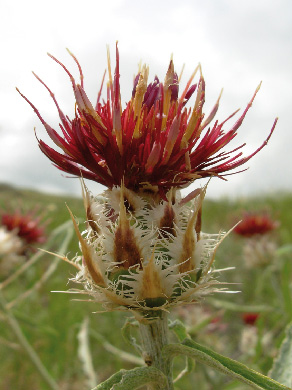Tomanthea daralaghezica: Red Data Book of Armenia

EN B 1 ab(i,ii,iii) + 2 ab(i,ii,iii)
Category. Endangered species. Endemic of South Transcaucasia. In Armenia it is known from two floristic regions. The extent of occurrence is less than 5000 km2, the area of occupancy is less than 500 km2. The species grows in the area of intensive land development. It was included in the first edition of the Red Data Book of Armenia under Category 3: Reducing species. It is not included in the Annexes of CITES and that of the Bern Convention.
Description. Perennial herbs. Stems erect, unbranched or weakly branched. Leaves entire or lyrate–dissected. Capitula heterogamous, large, terminal, solitary, many–flowered. Flowers dark wine–purple; corolla deeply incised; marginal flowers with very narrow lobes. Achenes 7 x 2 mm, slightly curved at base, light brown, at base whitish. Pappus 13–18 mm long, violet–purple.
Distribution. In Armenia it grows in Yerevan (Urts mountain range, "Khosrov Forest" State Reserve) and Darelegis (widespread) floristic regions. EOO is 3550 km2, AOO is 100 km2. The number of locations is 10. Besides Armenia the species grows in Nakhichevan.
Ecological, biological and phytocoenological peculiarities. Grows in middle and upper mountain belts, at the altitudes of 1100–2000 meters above sea level, on dry stony slopes, in wine yards, juniper open forests, mountain steppes, phryganoids. Flowering from June to July, fruiting from July to August.
Limiting factors. Restricted extent of occurrence and area of occupancy, loss/degradation of habitats caused by land development.
Conservation actions. Part of the population grows in the territory of "Khosrov Forest" State Reserve. Necessary: monitoring of the population state.
Suggestions
 The Ministry of Environment sent a letter international partners to draw their attention to the real danger of environmental disasters as a result of Azerbaijan's large-scale aggression towards the territory of Armenia
The Ministry of Environment sent a letter international partners to draw their attention to the real danger of environmental disasters as a result of Azerbaijan's large-scale aggression towards the territory of Armenia
 Vicia pisiformis: Red Data Book of Armenia
Vicia pisiformis: Red Data Book of Armenia
 Vavilovia formosa: Red Data Book of Armenia
Vavilovia formosa: Red Data Book of Armenia
 Trigonella capitata: Red Data Book of Armenia
Trigonella capitata: Red Data Book of Armenia
 Trigonella astroides: Red Data Book of Armenia
Trigonella astroides: Red Data Book of Armenia












